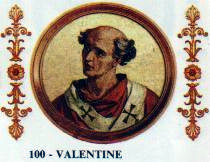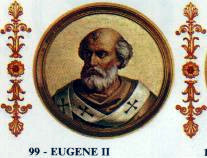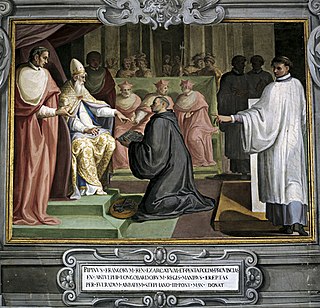The (Pactum) Ludovicianum (also spelled Ludowicianum or Hludowicianum) was an agreement reached in 817 between the Emperor Louis the Pious (“Ludovicus Pius”) and Pope Paschal I concerning the government of central Italy and the relation of the Papal States to the Carolingian Empire. [1] The text of the Ludovicianum is preserved mainly in eleventh- and twelfth-century manuscripts of canon law and has been reconstructed by modern editors. Certain sections of the Ludovicianum are thought to be confirmations of agreements made between Louis's father, Charlemagne, and Pope Hadrian I during the former's trips to Rome in 781 and 787.

Louis the Pious, also called the Fair, and the Debonaire, was the King of the Franks and co-emperor with his father, Charlemagne, from 813. He was also King of Aquitaine from 781.

Pope Paschal I was Pope from 25 January 817 to his death in 824.

Central Italy is one of the five official statistical regions of Italy used by the National Institute of Statistics (ISTAT), a first-level NUTS region and a European Parliament constituency.
The negotiations which resulted in the Ludovicianum began during the pontificate of Stephen IV, but the agreement was only concluded shortly after the election of his successor, Paschal I, in January 817. Stephen had anointed and crowned Louis and his wife, Irmingard, at Reims in October 816. In return Louis had granted the Pope everything he had requested, as recorded both in Stephen's biography in the Liber Pontificalis and Louis's biography, the Vita Hludovici imperatoris . Paschal, immediately after his election, sent an embassy to Louis requesting a confirmation of the pactum (agreement) that had been arranged with Stephen. [2]
Pope Stephen IV was Bishop of Rome and ruler of the Papal States from June 816 to his death in 817.

The Liber Pontificalis is a book of biographies of popes from Saint Peter until the 15th century. The original publication of the Liber Pontificalis stopped with Pope Adrian II (867–872) or Pope Stephen V (885–891), but it was later supplemented in a different style until Pope Eugene IV (1431–1447) and then Pope Pius II (1458–1464). Although quoted virtually uncritically from the 8th to 18th centuries, the Liber Pontificalis has undergone intense modern scholarly scrutiny. The work of the French priest Louis Duchesne, and of others has highlighted some of the underlying redactional motivations of different sections, though such interests are so disparate and varied as to render improbable one popularizer's claim that it is an "unofficial instrument of pontifical propaganda."
The earliest text purporting to be a complete version of the Pactum made between emperor and pope in 817 is found in late eleventh-century canon law texts, but based on a collection compiled by Cardinal Deusdedit to serve as a preliminary to his Collectio Canonum, finished in 1087. [3] Both Anselm of Lucca and Bonizo of Sutri copied the Ludovicianum into their collections of canon law. The text of the Ludovicianum closely resembles the later Pactum Ottonianum between Emperor Otto the Great and Pope John XII (962). A manuscript fragment that also closely resembles the Ludovicianum and may in fact be a copy of it survives from the ninth or early tenth century, and was first published by Angelo Mercati in 1926. It was written in Caroline minuscule on papyrus, a writing material only regularly in use in the scriptoria of the Papacy at the time. [4]
Deusdedit was the cardinal-priest of San Pietro in Vincoli.

Saint Anselm of Lucca, born Anselm of Baggio, was a medieval bishop of Lucca in Italy and a prominent figure in the Investiture Controversy amid the fighting in central Italy between Matilda, countess of Tuscany, and Emperor Henry IV. His uncle Anselm preceded him as bishop of Lucca before being elected to the papacy as Pope Alexander II; owing to this, he is sometimes distinguished as Anselm the Younger or Anselm II.
Bonizo of Sutri or Bonitho was a Bishop of Sutri and then of Piacenza in Central Italy, in the last quarter of the 11th century. He was an adherent of Gregory VII and an advocate of the reforming principles of that pope. He wrote three works of polemical history, detailing the struggles between civil and religious authorities. He was driven out of both of his dioceses, once by the emperor and once by opponents of Gregorian-style reform.

The Concordat of Worms, sometimes called the Pactum Calixtinum by papal historians, was an agreement between Pope Callixtus II and Henry V, Holy Roman Emperor on September 23, 1122, near the city of Worms. It brought to an end the first phase of the power struggle between the Papacy and the Holy Roman Emperors and has been interpreted as containing within itself the germ of nation-based sovereignty that would one day be confirmed in the Peace of Westphalia (1648). In part this was an unforeseen result of strategic maneuvering between the Church and the European sovereigns over political control within their domains. The King was recognised as having the right to invest bishops with secular authority in the territories they governed, but not with sacred authority. The result was that bishops owed allegiance in worldly matters both to the pope and to the king, for they were obliged to affirm the right of the sovereign to call upon them for military support, under his oath of fealty. Previous Holy Roman Emperors had thought it their right, granted by God, to name Church officials within their territories and to confirm the Papal election. In fact, the Emperors had been heavily relying on bishops for their secular administration, as they were not hereditary or quasi-hereditary nobility with family interests. A more immediate result of the Investiture struggle identified a proprietary right that adhered to sovereign territory, recognising the right of kings to income from the territory of a vacant diocese and a basis for justifiable taxation. These rights lay outside feudalism, which defined authority in a hierarchy of personal relations, with only a loose relation to territory. The pope emerged as a figure above and out of the direct control of the Holy Roman Emperor.

The Council of 1123 is reckoned in the series of Ecumenical councils by the Catholic Church. It was convoked by Pope Callixtus II in December, 1122, immediately after the Concordat of Worms. The Council sought to: (a) bring an end to the practice of the conferring of ecclesiastical benefices by people who were laymen; (b) free the election of bishops and abbots from secular influence; (c) clarify the separation of spiritual and temporal affairs; (d) re-establish the principle that spiritual authority resides solely in the Church; (e) abolish the claim of the emperors to influence papal elections.

Pope Gregory IV was Pope from October 827 to his death in 844. His pontificate was notable for the papacy’s attempts to intervene in the quarrels between the emperor Louis the Pious and his sons. It also saw the breakup of the Carolingian Empire in 843.

Pope Callixtus II or Callistus II, born Guy of Burgundy, was pope of the western Christian church from 1 February 1119 to his death in 1124. His pontificate was shaped by the Investiture Controversy, which he was able to settle through the Concordat of Worms in 1122.

Pope Sergius II was Pope from January 844 to his death in 847.

Pope Valentine was Pope for two months in 827.

Pope Eugene II was Pope from June 6, 824 to his death in 827. A native of Rome, he was chosen to succeed Paschal I. Another candidate, Zinzinnus, was proposed by the plebeian faction, and the presence of Lothair I, son of the Frankish emperor Louis the Pious, was necessary in order to maintain the authority of the new pope. Lothair took advantage of this opportunity to redress many abuses in the papal administration, to vest the election of the pope in the nobles, and to confirm the statute that no pope should be consecrated until his election had the approval of the Frankish emperor.
The Diploma Ottonianum was an agreement between Pope John XII and Otto I, King of Germany and Italy. It confirmed the earlier Donation of Pippin, granting control of the Papal States to the Popes, regularizing Papal elections, and clarifying the relationship between the Popes and the Holy Roman Emperors.
Christian I, sometimes Christian von Buch, was a German prelate and nobleman. He was Archbishop of Mainz and Archchancellor of Germany from 1165 until his death 1183. He was originally elected archbishop in 1160 in a disputed election. He served the Emperor Frederick I as a diplomat in Italy on two occasions.
The Constitutio Romana was drawn up between King Lothair I of Italy (818–855), co-emperor with his father, Louis the Pious, since 817, and Pope Eugene II (824–827) and confirmed on 11 November 824. At the time the election of Eugene was being challenged by Zinzinnus, the candidate of the Roman populace. Eugene agreed to several concessions to imperial power in central Italy in return for receiving the military and juridical support of Lothair. The Constitutio was divided into nine articles. It introduced the earliest known Papal Oath, which the Pope-elect was to give to an imperial legate before receiving consecration. It also restored the custom established by Pope Stephen III in 769 whereby both the laity and clergy of Rome would participate in Papal elections.
Collections of ancient canons contain collected bodies of canon law that originated in various documents, such as papal and synodal decisions, and that can be designated by the generic term of canons.
In nomine Domini is a papal bull written by Pope Nicholas II and a canon of the Council of Rome. The bull was issued on 13 April 1059 and caused major reforms in the system of papal election, most notably establishing the cardinal-bishops as the sole electors of the pope, with the consent of minor clergy.

From 756 to 857, the papacy shifted from the orbit of the Byzantine Empire to that of the kings of the Franks. Pepin the Short, Charlemagne, and Louis the Pious had considerable influence in the selection and administration of popes. The "Donation of Pepin" (756) ratified a new period of papal rule in central Italy, which became known as the Papal States.

Henry V was King of Germany and Holy Roman Emperor, the fourth and last ruler of the Salian dynasty. Henry's reign coincided with the final phase of the great Investiture Controversy, which had pitted pope against emperor. By the settlement of the Concordat of Worms, he surrendered to the demands of the second generation of Gregorian reformers.
Ingoald was the Abbot of Farfa from 815, succeeding Benedict. At the beginning of his abbacy he vigorously protested the policies of Pope Leo III (795–816), which had resulted in the abbey's loss of property. Ingoald complained about not only the—illegitimate, as he saw it—seizure of Farfa's lands, but also the application of dubious laws of Roman origin in a zone that followed Lombard law. While Ingoald also fostered close contacts with the Carolingian rulers of Francia and Lombardy, he resisted secular encroachments on the abbey's privileges as staunchly as he resisted papal ones. The rate of property transactions at Farfa seems to have peaked under Ingoald, but the surviving documentary evidence is far from complete.
Libellus de imperatoria potestate in urbe Roma is an anonymous Latin treatise on the authority of the Holy Roman Emperor in the city of Rome. It has been dated as early as the late 9th century and as late as the middle of the 10th. It was probably written at Spoleto. It survives in one manuscript, which was appended to the a contemporary work, Chronicon by Benedict of Sant'Andrea.
The Annales Beneventani, also called the Breve chronicon monasterii Sanctae Sophiae Beneventi or Chronicon Sanctae Sophiae for short, is a series of Latin annals from the monastery of Santa Sofia in Benevento, southern Italy. The annal entries were originally annotations written in the margins of Paschal tables, a practice that probably dates to the foundation of the monastery in the second half of the eighth century. The annotations were gathered together and copied into manuscripts in the early twelfth century. Three such manuscripts exist, each copied at Santa Sofia and each presenting a different redaction of the annals. The Annales is of interest primarily because its entries are roughly contemporaneous with the events they describe.













